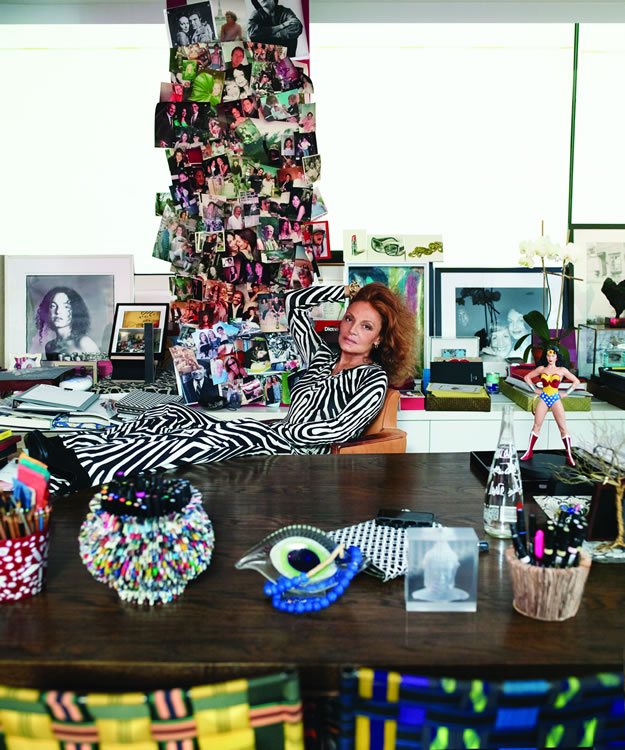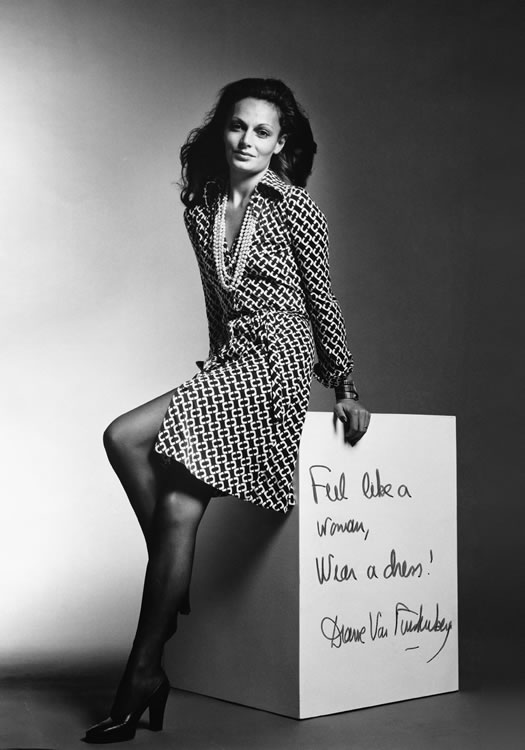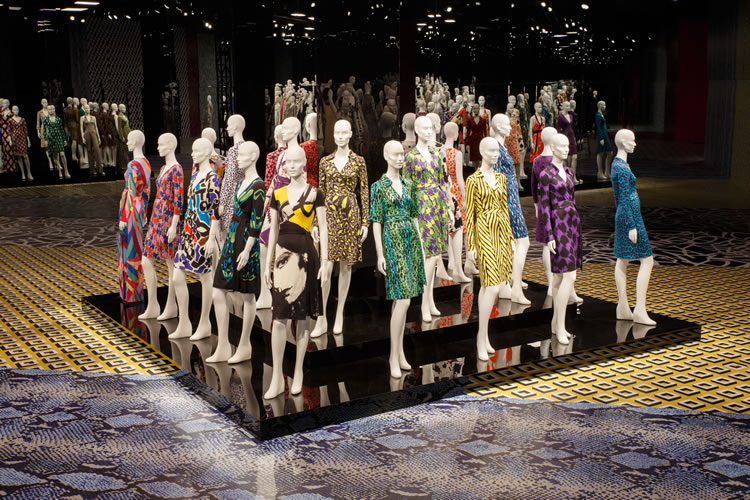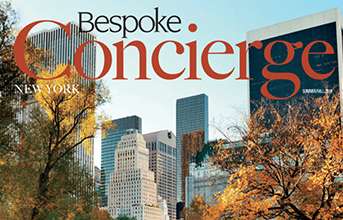
After 40 years, the iconic wrap dress made famous by legendary fashion designer Diane von Furstenberg remains a mark of feminism, femininity and freedom.
By Bria Ballet
When a young Diane von Furstenberg set off to New York City in 1970 on the arm of her new husband, Prince Egon von Furstenberg of Germany, the raven-haired beauty knew that she wanted to maintain her career and independence in addition to her new marriage.
The child of a holocaust survivor, von Furstenberg was born and raised with an instinct for self-reliance and was intent on forging her own path in life. Armed with a suitcase full of dresses she had crafted at a friend’s clothing factory in Italy, the princess began her American life as a fashion designer, quickly taking the city by storm. In 1974, after only a couple of years in the business, von Furstenberg, who was 26 years old at the time, created a simple jersey frock that instantly became one of the most influential pieces in the style industry—the wrap dress.
During a period when many women were entering the white-collar work force and declaring their sexual independence, the dress wasn’t just a piece of clothing; it was a symbol of female empowerment. That same year, the popularity of the dress propelled the designer into fashion fame. She was soon gracing the covers of major publications, including Newsweek, Interview magazine and The Wall Street Journal.
Although her marriage to Prince Egon von Furstenberg only lasted briefly—they divorced shortly after their move to New York—the fashion movement that it created has spanned four decades and touched more than 55 countries. This year, the dress that started it all celebrates its 40th anniversary amid renewed popularity as well as a reputation as the world’s most flattering frock.
Style Empowerment
Von Furstenberg’s initial design proved that despite being a newcomer to the fashion world, her instincts for what women needed were spot on. Using herself as a muse, she followed a vision of not only what she wanted the American woman to be, but also what she hoped to become. Inspired by a wrap-style top frequently worn by ballerinas, she crafted a simple silhouette out of silk jersey that skimmed the body and was incredibly comfortable. Launched in 1974, the wrap dress was an immediate success, prompting fans and members of the fashion world to tout its comfort, style and flattering construction—praises that continue to this day.

“The wrap dress is probably the most ageless and flattering dress in fashion history,” says Edward Enninful, fashion and style director for W magazine. “The prints have evolved beautifully for 40 years, marking distinct moments in time, and yet they are always fresh and never feel dated.”
When von Furstenberg entered the fashion world in the 1970s, it was during the midst of a groundbreaking movement toward female equality. The debut of the wrap dress coincided with women’s newfound interests in professional power and redefining their roles in society. The more flattering, womanly garment immediately made pantsuits—the feminist style du jour—look passe.
“Diane was able to glamorize and bring a sense of confidence and femininity to a time when women were really grappling with what to wear when they went to work,” says Patricia Mears, deputy director of The Museum at FIT (the Fashion Institute of Technology) in New York. “[She brought] something aside from a female version of the gray flannel suit.”
Fittingly, her first ad campaign in 1972 for the wrap dress featured the young designer seductively leaning against a white block, which had been tagged with a message from von Furstenberg herself. It read, “Feel like a woman, wear a dress!”—words that succinctly described the designer and her fashion philosophy. Her celebration of the female body sent a message to women: They could still achieve success and respect without having to hide their bodies behind desexualized clothing.
“Diane is the pioneer of women empowerment. … Strong color and strong patterns for strong women,” says Laurie Brucker, a certified image consultant and personal stylist with Los Angeles-based LaurieBstyle.
Throughout her career, von Furstenberg’s commitment to empowering women around the world has never wavered. What started as a simple dress has morphed into a symbol of feminine power and cemented von Furstenberg’s status as a fashion icon. However, instead of being satisfied with her early success, she chose to create a revolution.
Creating an Empire
In 1976, two years after the launch of the wrap dress, which had already sold more than 1 million garments, von Furstenberg’s face and frock were splashed across the cover of Newsweek; the magazine declared her “the most marketable female in fashion since Coco Chanel.”

“In its heyday … tens of thousands of them were sold each week,” Mears says. “These dresses found their way into every part of American life for women in that time period.”
At only 28 years old, the princess-turned-tastemaker had garnered admiration from women all over the world, and she used her influence to encourage them to embrace their femininity. “[Von Furstenberg] designs every single piece with women in mind,” Brucker says. “[It gives them] the opportunity to feel sexy and feminine.”
Women of all ages and bodies felt beautiful in her designs, and their loyalty provided a strong foundation for a blossoming career. “The wrap dress is, essentially, the perfect piece for a woman’s figure,” Brucker adds. “[It] flows with the female form so perfectly that you can’t not feel feminine and sexy and wonderful in it, which is a wonderful way to feel in every aspect of our lives.”
In the years that followed her initial success, von Furstenberg worked to expand her fashion empire, delving into the world of cosmetics, where she continued to triumph. Her first fragrance, named after her daughter Tatiana, helped bring the Diane von Furstenberg name to the forefront of the beauty world and into the 1980s. Her reign lasted several more years as people clamored for her designs and cosmetics, but after a decade-long career in the spotlight, issues with licensing and brand management encouraged von Furstenberg to sell her beauty line to an outside company.
“She, like everybody who [was] starting to expand their business at that time [in the late 1980s], went through kind of a rough and tumble period,” Mears explains.
While she took a brief step out of the limelight, von Furstenberg never lost her passion for design or her fans. When she returned to relaunch her brand in 1997, she did so with a specific goal in mind: to empower a new generation of women, just as she had done more than two decades earlier.
The new wave of women who discovered von Furstenberg’s dress found the very same aspects to love as women in the 1970s. Brilliant in its design and convenience—it can be slipped on or off in a matter of seconds—the dress has taken on a life of its own with new incarnations and prints, including a limited-edition collection with the Andy Warhol Foundation in celebration of the 40-year anniversary, alongside popular classics.
Forever a Visionary
Despite all of von Furstenberg’s other obligations and responsibilities, she remains, first and foremost, a designer. With every facet that has developed within her career, she has managed to remain true to her concept for the brand and the confidence she wants women to exude when wearing her clothing.

“Even though, seasonally, fabrics change and styles change, … her vision is so consistently her,” Brucker says. “Everything she does is timeless because she always stays true to her own vision.” This consistency was the key to her success when she relaunched her brand on the cusp of the new millennium, inspired by a new generation of women who were scouring vintage stores and flea markets for some of her original designs.
While von Furstenberg has certainly made an impact on the fashion industry, she’s also using her influence for the greater good. Along with her husband Barry Diller—whom she married in 2001—von Furstenberg supports numerous charity organizations through their Diller-von Furstenberg Family Foundation (DvFFF). Dedicated to supporting nonprofits that strengthen communities and improve lives, the DvFFF has operated since 1999.
Von Furstenberg’s contributions to fashion and her philanthropic efforts did not go unnoticed by her peers. In 2005, she was presented with the Council of Fashion Designers of America’s (CFDA) Lifetime Achievement Award. One year later, she accepted a position as the organization’s president, a role she holds to this day.
“She is such a good human being that it is probably something she has carried all of her life,” says Mears. “I think it’s integral to what she stands for. … You can’t separate the philanthropic efforts from the person.”
Between the efforts of her own organizations and those of the CFDA, von Furstenberg’s commitment to charity has set her apart as an icon in the truest sense of the word. Never one to slow down, in 2010, von Furstenberg founded the DVF Awards, a yearly event honoring women around the world who have encouraged positive change within their communities and across the globe. On behalf of the DvFFF, each of the five honorees receives a donation of $50,000 to contribute to their causes.
“Diane has been at the forefront of American fashion for 40 years; this alone makes her an icon,” Enninful says. “Her commitment to charity, her passion for women and her remarkable beauty enforce her iconic stature.”
As von Furstenberg continues to evolve her brand, which has expanded to include shoes, handbags and accessories, in addition to ready-to-wear pieces, it’s clear that no matter what she does, women around the world will be watching. She inspires them not only with her clothing but also with her vision for what being a woman should mean. Her embodiment of independence, femininity and power remains her greatest draw.
“She still is a tremendous inspiration to so many women,” Mears says. “And I’m hoping … that the 40th anniversary is not her [only] major anniversary—that we will continue to see more.”







